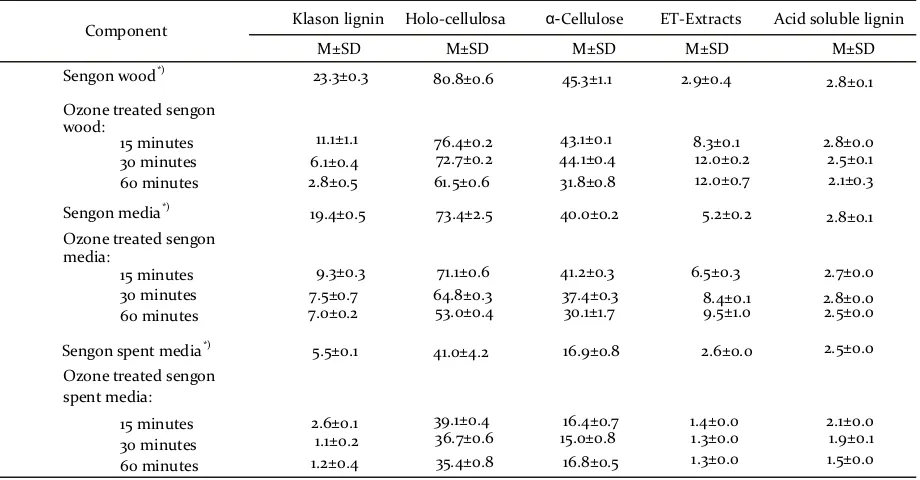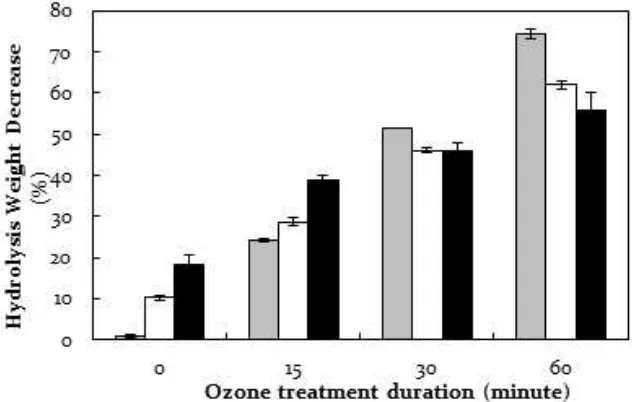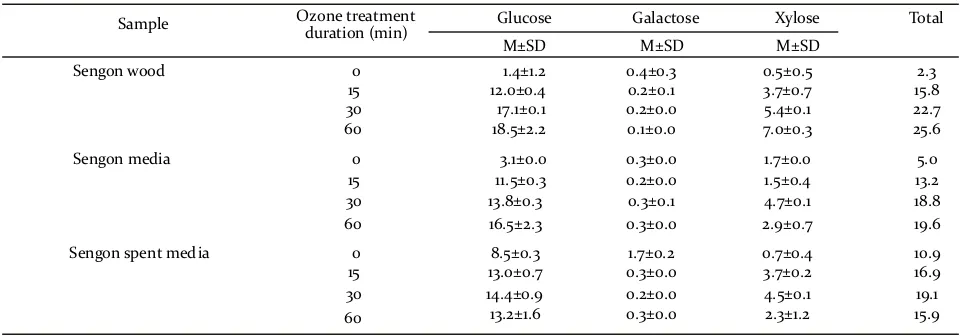Association of Mushroom Cultivation and Ozonolysis as Pretreatment
for Enzymatic Saccharification of Sengon(
Falcataria moluccana
)
Sawdust
Gabungan Pra-perlakuan Ozonolisis dan Budidaya Jamur Sebelum Sakarifikasi Enzimatis
Serbuk Kayu Sengon (Falcataria moluccana)
Denny Irawati1*, Soekmana Wedatama1, Futoshi Ishiguri2, & Shinso Yokota2
1
Faculty of Forestry, Gadjah Mada University, Jl. Agro No.1 Bulaksumur, Sleman, 55281 Indonesia
2
Faculty of Agriculture, Utsunomiya University, 350 Mine-machi, Utsunomiya, Tochigi, 321-8505 Japan *
Email: dirawati@ugm.ac.id
Journal of Forest Science
https://jurnal.ugm.ac.id/jikfktRESEARCH PAPER
Article history:
Received (masuk): 3 Maret 2017
Accepted (diterima): 15 Agustus 2017
KEYWORDS
sengon spent media ozone treatment
enzymatic saccharification reducing sugars
ABSTRACT
Wood industry based on sengon (Falcataria moluccana) material has developed rapidly and cause the huge wastes. Lignocellulosic materials, such
Introduction
S
engon (Falcataria moluccana) is a fast-growing tree species generally used as raw material for pulp and paper manufacture. Indonesian wood industries are currently using sengon not only for pulpwood butalso for light construction, furniture, and wood composite for construction (plywood and laminated
veneer lumber). In the island of Java, sengon timber
production reaches 2 million m3/year and causes timber industries based on sengon materials have developed rapidly. On the other hand, the industries also cause side effects such as waste sawdust especially from sengon. Most of the wastes of sawdust sengon are used by farmers to make cultivation media of wood mushrooms. However, after cultivation, residues of the media have also become a new problem. Media were dumped into the environments may decay and release methane gases that causes greenhouse gases to the atmosphere.
Lignocellulosic materials, such as sengon sawdust wastes, offer a great potential as cheap and
abundant feedstock for biofuels production. Enzymatic hydrolysis of the cellulose fraction yields glucose that is fermented to obtain fuel-grade ethanol.
The main disadvantage to produce economically ethanol from lignocellulosic materials is its low
digestibility due to the complex chemical structure. Lignocellulosic materials are formed by cellulose,
hemicellulose and lignin, closely linked. Lignin significantly impacts enzymatic hydrolysis of
lignocellulosic biomass. Therefore, a pre-treatment step has to be considered because of the high crystallinity of the cellulose and the presence of lignin.
The pre-treatment step should improve the accessibility of hydrolytic enzymes to cellulose.
Moreover, the pretreatment should avoid degradation of hemicellulose and cellulose because sugar
degradation not only decreases ethanol yield but also produces degradation products that are inhibitory to
INTISARI
Industri kayu berbahan baku kayu sengon (Falcataria moluccana) saat ini tengah berkembang dengan sangat pesat dan hal ini menyebabkan timbulnya banyak limbah kayu sengon. Materi lignosellulosa, seperti limbah serbuk kayu sengon, merupakan potensi yang sangat baik sebagai
bahan baku bio-fuel karena murah dan banyak tersedia. Praperlakuan dengan oksidasi ozon pada limbah kayu sengon dilakukan untuk meningkatkan produksi gula reduksi melalui proses sakarifikasi enzimatis. Serbuk sengon (SW), media sengon (SM), dan limbah media sengon (SMM), yang merupakan sisa dari media budidaya jamur, diberi perlakuan dengan ozon pada berbagai lama waktu perlakuan. Sampel yang sudah diberi perlakuan ozon tersebut kemudian dianalisis kandungan kimianya dan di-sakarifikasi secara enzimatis. Selanjutnya diukur laju hidrolisis, kadar gula pereduksi, dan kadar monosakarida. Perlakuan dengan ozon menyebabkan degradasi kadar Klason lignin di semua sampel, sehingga mengakibatkan peningkatan kemampuan sakarifikasi dari enzim. Perlakuan ozon dengan lama waktu lebih dari 30 menit tidak sesuai untuk sampel SMM. Kadar glukosa hasil sakarifikasi yang tinggi diperoleh dari sampel SW dan SM yang diberi perlakuan ozon selama 60 menit, serta SMM yang diberi perlakuan 30 menit. Berdasarkan hasil ini, dapat disimpulkan bahwa perlakuan jamur dapat mengurangi lama waktu perlakuan ozon dan praperlakuan efektif untuk meningkatkan kadar gula reduksi yang dihasilkan dari sakarifikasi enzimatis limbah kayu sengon.
KATA KUNCI
sengon sisa media ozon
sakarifikasi enzim gula pereduksi
the yeast used in the subsequent fermentation (García-Cubero et al. 2010).
One of the best studied pretreatment is ozonisation. Ozone is known to be a powerful oxidizing reagent and has a potential to degrade lignin
without producing harmful compounds (Yokota et al. 2007). Ozone is highly reactive toward compounds
with double bonds and functional groups (Sarkanen et al. 1992; Garcia-Cubero et al. 2009). In terms of pre-treating lignocellulose for subsequent enzymatic saccharification, the advantage of ozone treatment is
highly selective to removal of lignin with slight degradation of hemicelluloses, whereas it hardly
affects cellulose (Sun & Cheng 2002). Moreover, ozone reaction can be performed at room temperature under atmospheric pressure, leading to a low pretreatment
cost.
The result of ozonisation is not complete
mineralisation of such products, but rather formation of a variety of oxidised intermediates, whose
concentrations dependent on the reaction time (Amat et al. 2003). The previous study of ozone oxidation
pretreatment that was carried out on spent culture media (SCMs) of Quercus serrata after Lentinula edodes cultivation resulted that 1 h was an effective
duration (Ueda et al. 2013). In addition, the type of material also influences the effectiveness of ozonation
process (García-Cubero et al. 2010).
Sengon sawdust and mushroom cultivation media waste have different chemical contents. Mushroom cultivation media waste has a lower lignin content because the content of lignin was reduced during the growth of fungi (Irawati et al. 2012a). In this study, we observed the optimal duration of ozone treatment for sengon wood waste and sengon that was used for mushroom cultivation (spent media). Ozone-treated samples were enzymatically saccharified, and hydrolysis weight decrease, reducing sugar yield, and monosaccharide yields were determined. Based on the results obtained, the effects
of ozone treatment on enzymatic saccharification on sengon waste were discussed.
Materials and Methods
Biomass materials
Wood meals (in sawdust size about 9–80 mesh) of sengon (Falcataria moluccana) with 8.3% moisture content (MC) used in this study. The wood meal also was used for cultivation experiment of wood ear mushroom (Auricularia polytricha). After inoculation of A. polytricha, the media were cultured for 130 days in a culture room as previously described (Irawati et al. 2012b).
Ozone treatment
In ozone treatment, ozone was produced by an ozonizer (ED-OG-R6, EcoDesign, Japan) at a flow rate of 50 mL/min. Before ozone treatment, the samples were dried in the oven at 45oC. The dried sample (1 g) was put in a Kjeldahl flask (100 mL) and then MC of the sample was adjusted to 40 % with distilled water. Ozone treatment was done using 6 % concentration of ozone (0.26 g/h flow rate) for 15, 30, and 60 minutes.
Chemical component analysis
Before chemical analysis, the samples were ground by a rotary speed mill (P-14, Fritsch) and then sieved to collect samples in 40–80 mesh size. After that, the samples were dried in an oven at 45oC. The amounts of a-cellulose, Klason lignin, and
decrease ratio in a bag from SM to sengon spent media (SSM) and also weight loss during ozone treatment.
Enzymatic saccharification
A commercial enzyme, Meiselase (Meiji Seika), was used for the saccharification of each sample. Two hundred mg of oven-dried sample (40–80 mesh size) was saccharified by 50 mg of enzyme at 40oC for 48 h (Irawati et al. 2012a). Hydrolysis weight decrease (HWD) is the numbers of samples which was hydrolized, it is calculated by comparing the weight of hydrolized samples with the weight of original samples before treatment. Monosaccharides was quantified by using high-performance anion-exchange chromatography (DX 500, Dionex) (Irawati et al. 2013). Reducing sugar yield was determined by the dinitrosalicylic acid (DNS) method (Miller 1959). Enzymatic saccharification was conducted three times for each sample. Qualitative and quantitative analyses of the monosaccharides were carried out using a high-performance anion exchange chromatography (HPAE) system (DX500, Dionex, USA) equipped with a pulsed amperometric detector (ED40, Dionex). The analytical column was a CarboPacTM PA-1 column (4 x 250 mm, Dionex) connected with a CarboPacTM PA-1 guard column (4 x 50 mm, Dionex). Temperature of the column oven (Model 502, EYELA) was set at 30oC. The mobile phase consisted of ultrapure water (A), 100 mM sodium hydroxide (B), and 250 mM sodium hydroxide (C). Eluent flow was set at 1.0 mL/min. Galactose (Wako Pure Chemical Industries, Ltd.), glucose, and xylose (Wako Pure Chemical Industries, Ltd.) were used as standard monosaccharides. For monosaccharide analysis, a freeze-dried sample was dissolved in 10 mL distilled water. After that, the sample (1 mL) was filtered through Millex-L (0.20 lm, Millipore, USA), and then 10 µL of filtered sample was injected onto the HPAE system.
Results and Discussion
Effect of ozone treatment duration
Changes in chemical component contents during ozone treatment with different treatment times are shown in Table. 1. Chemical contents differences among SW and SM were caused by the addition of other ingredients in the media (such as bran and CaCO3), while among SM and SSM were caused by the
activity of fungi that degraded media during its growth. Differences in chemical contents which were showed among SW and SWO, SM and SMO, and SSM and SSMO occurred due to ozone treatment.
In this study, the Klason lignin content in ozone treated samples decreased with an increase in ozone treatment duration. In addition, holocellulose content also decreased gradually over 60 min of ozone treatment, while á-cellulose did not change significantly throughout the treatment. These results suggest that ozone treatment resulted in the degradation of lignin and hemicellulose in the samples. In general, ozone treatment mainly degrades lignin but also hemicellulose in lignocellulosic biomass, whereas cellulose is only slightly affected (Quesada et al. 1999; Sun & Cheng 2002).
straw, which probably caused by the differences of used biomass.
Effect of ozone treatment on enzymatic saccharification
The previous research pointed out that lignin inhibits enzymatic saccharification by limiting the enzyme accessibility to polysaccharides and by absorbing enzymes (Sun & Cheng 2002). Garcia-Cubero et al. (2010) reported a proportional increase in sugar production with lignin degradation by ozone pretreatment.
The effects of the duration of ozone treatment on HWD after saccharification are shown in Fig. 1. The largest HWD (74.3%) after saccharification was obtained after ozone treatment wood for 60 min. HWD increased along with the ozone treatment duration and the increase ratio of SSM from 30 to 60 min duration was the lowest one. These results showed that ozonisation for 60 min was not effective
for SSM and the optimum duration for SSM was 30 min.
Reducing sugar yield from the SW sample increased up to 60 min ozone treatment (Fig. 2). On the other hand, the reducing sugar yield of SM and SSM samples increased up to 30 min and then decreased. These results probably caused by holocellulose dan cellulose contents which are low wood carbohydrates in SSM. Even though A. polytricha is classified as Basidiomycetes which degrades lignin during their growth, the previous research in 5 Japanese species also showed that A. polytricha degraded cellulose dan holocellulose (Irawati et al. 2012a).
Furthermore, significant correlation was obtained between Klason lignin content and reducing sugar yield or hydrolisis weight decrease (Figure 3). Table 2 shows the monosaccharide yield after saccharification of the samples. After saccharification, glucose was the major monosaccharide, followed by
Ozone treated sengon spent media:
15 minutes 2.6±0.1 39.1±0.4 16.4±0.7 1.4±0.0 2.1±0.0
30 minutes 1.1±0.2 36.7±0.6 15.0±0.8 1.3±0.0 1.9±0.1
60 minutes 1.2±0.4 35.4±0.8 16.8±0.5 1.3±0.0 1.5±0.0
Sengon spent media*) 5.5±0.1
41.0±4.2 16.9±0.8 2.6±0.0 2.5±0.0
Sengon media*) 19.4±0.5 73.4±2.5 40.0±0.2 5.2±0.2 2.8±0.1
Ozone treated sengon media:
15 minutes 9.3±0.3 71.1±0.6 41.2±0.3 6.5±0.3 2.7±0.0
30 minutes 7.5±0.7 64.8±0.3 37.4±0.3 8.4±0.1 2.8±0.0
60 minutes 7.0±0.2 53.0±0.4 30.1±1.7 9.5±1.0 2.5±0.0
Component Klason lignin Holo-cellulosa- Cellulose ET-Extracts Acid soluble lignin
M±SD M±SD M±SD M±SD
Sengon wood*) 23.3±0.3 80.8±0.6 45.3±1.1 2.9±0.4 2.8±0.1
Ozone treated sengon wood:
15 minutes 11.1±1.1 76.4±0.2 43.1±0.1 8.3±0.1 2.8±0.0
30 minutes 6.1±0.4 72.7±0.2 44.1±0.4 12.0±0.2 2.5±0.1
60 minutes 2.8±0.5 61.5±0.6 31.8±0.8 12.0±0.7 2.1±0.3
M±SD
*). Irawati et al., 2013.
Note : M=mean, SD=standard deviation, ET=ethanol-toluene Keterangan : M=rerata, SD=standar deviasi, ET=etanol-toluena
Table 1. Chemical components (%) of sengon wood, spent media, and ozone treated wood and spent media in several treatment times.
xylose and galactose. In addition, glucose yield of SW and SM increased along with the ozone treatment duration, but not for SMM samples. Cellulose structure in SSM may have been degraded by enzymes of mushroom, so that long ozone treatment causes many glucose degradations. These results indicate that lignin degradation by ozone pretreatment for 60 min improved effectively the accessibility of the
enzyme to cellulose during the saccharification for SW sample. Further, it had caused too high degradation for monosaccharides and caused decreases of glucose and xylose yields. From these results, the optimal duration of ozone treatment to obtain the highest glucose yield from the SW or SM by enzymatic saccharification was 60 min, however for SMM was 30 min.
Figure 1. The histogram of hydrolysis weight decrease of the ozone treated samples in different duration treatment. Gray color is sengon wood. White color is sengon media. Black color is sengon spent media. Bars indicate the value of standard deviations.
Gambar 1. Histogram laju hidrolisis dari sampel yang diberi perlakuan ozon pada berbagai lama waktu perlakuan. Warna abu-abu adalah kayu sengon, putih adalah media, dan hitam adalah limbah media. Garis menunjukkan nilai standar deviasi.
Figure 2. The histogram of reducing sugar yield of the ozone treated samples in different duration treatment. Bars indicate the value of standard deviations. Refer Fig 1. For the different color.
Conclusions
The ozone treatment duration were determined for sengon wastes as reducing sugar feedstock. Ozone treatment resulted Klason lignin degradation in the all samples, resulting the improvement of subsequent enzymatic saccharification. Ozone treatment with the duration more than 30 min is not suitable for SMM sample. Glucose yield after saccharification from the ozone-treated sample for 60 min was the highest among all samples in SW and SM treated, but for SMM it was 30 min. Based on these results, we concluded
that mushroom cultivation can reduce the ozone time treatment and it is an effective treatment to improve sugar yield by enzymatic saccharification of sengon waste.
References
Anonimous. 2000. Analysis of main chemical components in wood. pp 94–97 in The Japan Wood Research Society editor. Manual for wood research experiment (In Japanese). Buneido, Tokyo,
Amat AM, Arques A, Beneyto H, Garcýa A, Miranda MA, Segu S. 2003. Ozonisation coupled with biological degradation for treatment of phenolic pollutants: a mechanistically based study. Chemosphere 53: 79–86.
Sample Ozone treatment duration (min) Glucose Galactose Xylose Total
M±SD M±SD M±SD
Sengon wood 0 1.4±1.2 0.4±0.3 0.5±0.5 2.3
15 12.0±0.4 0.2±0.1 3.7±0.7 15.8
30 17.1±0.1 0.2±0.0 5.4±0.1 22.7
30 14.4±0.9 0.2±0.0 4.5±0.1 19.1
60 13.2±1.6 0.3±0.0 2.3±1.2 15.9
Table 2. Monosaccharide yield (g/100 g biomass) after saccharification of ozone treated samples
Tabel 2. Rendemen monosakarida (g/100 g biomasa) hasil sakarifikasi sampel yang diberi perlakuan ozon
Figure 3. Correlations between Klason lignin content and reducing sugar yield or hydrolysis weight decrease in the treated and ozone untreated SW, SM, and SMM. Black square is reducing sugar yield (r=-0.80). White diamond is hydrolisis weight decrease (r=-0.79), n = 12.
Carrier M, Serani AL, Denux D, Lasnier JM, Pichavant FH, Cansell F, & Aymonier C. 2011. Thermogravimetric analysis as a new method to determine the lignocellulosic composition of biomass. Biomass and Bioenergy 35:298–307.
Dence CW. 1992. The determination of lignin. pp 33–61 dalam Lin SY, Dence CW, editors. Methods in lignin chemistry. Springer Verlag, New York.
Garcia-Cubero MT, Gonza´lez-Benito G, Indacoechea I, Coca M, Bolado S. 2009. Effect of ozonolysis pretreatment on enzymatic digestibility of wheat and rye straw. Bioresources Technology 100: 1608–1613. Garcia-Cubero MT, Coca M, Bolado S, & Gonzalez-Benito G.
2010. Chemical oxidation with ozone as pre-treatment of lignocellulosic materials for bioethanol production. Chemical Engineering Transactions 21: 1273-1278. Irawati D, Yokota S, Niwa T, Takashima Y, Ueda C, Ishiguri
F, Iizuka K, Yoshizawa N. 2012a. Enzymatic saccharification of spent wo od-meal media made of 5 different tree species after cultivation of edible mushroom Auricularia polytricha. Journal of Wood Science 58:180–183.
Irawati D, Hayashi C, Takashima Y, Wedatama S, Ishiguri F, Iizuka K, Yoshizawa N, Yokota S. 2012b. Cultivation of the edible mushroom Auricularia polytricha using sawdust-based medium made of three Indonesian commercial plantation species, Falcataria moluccana, Shorea sp., and Tectona grandis. Micologia Aplicada International 24:33–41.
Irawati D, Takashima Y, Ueda C, Sutapa JPG, Marsoem SN, Ishiguri F, Iizuka K, Yoshizawa N, Yokota S. 2013. Ozone treatment of spent medium from Auricularia polytricha
cultivation for enzymatic saccharification and subsequent ethanol production. Journal of Wood Science 59:522–527.
Miller GL. 1959. Use of dinitrosalicylic acid reagent for determination of reducing sugar. Analytical Chemistry 31:426–428.
Quesada J, Rubio M, Go´mez D. 1999. Ozonation of lignin rich solid fractions from corn stalks. Journal of Wood Chemistry and Technology 19:115–137.
Sarkanen KV, Islam A, Anderson CD. 1992. Ozonation. pp 387–406 dalam Lin SY, Dence CW, editors. Methods in lignin chemistry. Springer Verlag, New York.
Sun Y, Cheng J. 2002. Hydrolysis of lignocellulosic materials for ethanol production: A review. Bioresources Technology 83:1–11.
Ueda C, Takashima Y, Ishiguri F, Iizuka K, Yoshizawa N, Yokota S. 2014. Ozone oxidation pretreatment for enzymatic saccharification of spent culture media after
Lentinula edodes cultivation. Journal of Wood Science 61(1):65-69. DOI 10.1007/s10086-014-1441-z.
Yasuda S, Fukushima K, Kakehi A. 2001. Formation and chemical structures of acid-soluble lignin I: sulfuric acid treatment time and acid-soluble lignin content of hardwood. Journal of Wood Science 47:69–72.


